SPEAK INDONESIAN WITH CONFIDENCEESSENTIALINDONESIANPHRASEBOOK & DICTIONARYRevised Edition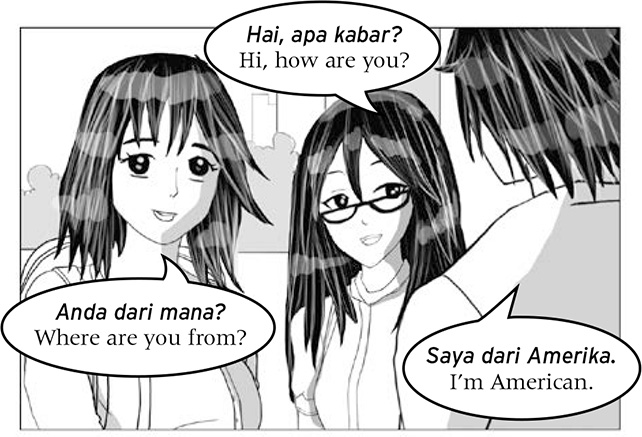 Tim Hannigan and Katherine Davidsen Tim Hannigan and Katherine Davidsen Introduction Welcome to the Tuttle Essential Language series, covering all the most popular Asian languages. These books are basic guides to communicating in the language. Theyre concise, accessible and easy to understand, and youll find them indispensable on your trip abroad to get you where you want to go, pay the right prices and do everything youve been planning to do. This book is divided into 14 themed sections. It starts with a pronunciation guide which explains the pronunciation of all the words and sentences youll be learning, and a grammar guide to help you construct basic sentences in Indonesian. The back of this book has a handy EnglishIndonesian dictionary that you can use to look up basic words. Introduction Welcome to the Tuttle Essential Language series, covering all the most popular Asian languages. These books are basic guides to communicating in the language. Theyre concise, accessible and easy to understand, and youll find them indispensable on your trip abroad to get you where you want to go, pay the right prices and do everything youve been planning to do. This book is divided into 14 themed sections. It starts with a pronunciation guide which explains the pronunciation of all the words and sentences youll be learning, and a grammar guide to help you construct basic sentences in Indonesian. The back of this book has a handy EnglishIndonesian dictionary that you can use to look up basic words. Throughout the book youll come across boxes with the  sign beside them. These are designed for situations where you dont understand what someone is saying to you. You can show the book to them and ask them to point to the correct answer to the question you are asking. Other boxes in the bookwithout the symbolprovide listings of themed words with their English translations beside them. For extra clarity, all Indonesian words and phrases are in italics. This book covers every situation you are likely to encounter during your visit, from checking into a hotel to booking a bus or train ticket to shopping and ordering food and drinks at a restaurant. sign beside them. These are designed for situations where you dont understand what someone is saying to you. You can show the book to them and ask them to point to the correct answer to the question you are asking. Other boxes in the bookwithout the symbolprovide listings of themed words with their English translations beside them. For extra clarity, all Indonesian words and phrases are in italics. This book covers every situation you are likely to encounter during your visit, from checking into a hotel to booking a bus or train ticket to shopping and ordering food and drinks at a restaurant. It even tells you what to say if you get lost or if you lose something. With over 2,000 commonly-used words and phrases at your fingertips you can rest assured that you will be able to deal with any situation, so let Essential Indonesian become your passport to learning to speak with confidence! Pronunciation guide Unlike English, Indonesian uses a very consistent phonetic spelling system and once youve learnt the rules you should be able to work out how to say any word you see written down. For the most part, its relatively easy for English speakers to get to grips with basic Indonesian pronunciation, though learning to accurately mimic the native speaker-style intonation takes a bit longer. Generally a fairly equal stress is placed on the different syllables in Indonesian words, though a slight extra stress is often placed on the next to last syllable in words of three syllables or more. Consonants The consonants b, d, f, g, j, k, l, m, n, p, s, t, w are all pronounced about the same way as in English. Q is pronounced like k in English. Z sometimes sounds similar to j in English. Z sometimes sounds similar to j in English. Consonants that are pronounced differently in Indonesian from English are the following: | c | pronounced like the ch in church ; example: cokelat = chocolate | | kh | a raspy k sound like the ch in loch ; example: khidmat = service | | ny | pronounced like the ny in canyon ; example: tanya = to ask | | r | rolled, as in Spanish or Italian; example: tari = to dance | | sy | pronounced like the sh in shall ; example: syarat = conditions |
The Indonesian consonant that generally gives English speakers most trouble is ng, although it is actually a sound that commonly occurs in English. The important thing to remember is that the sound changes slightly if it is immediately followed by another g. | ng | pronounced like the ng in singer; example: ingat = to remember | | ngg | pronounced like the ng in anger; example: tanggal = date |
Aspirated and unaspirated consonantsH is aspiratedgiven an extra little push of breathwhen it occurs at the end of a word; at the start or middle of a word it is pronounced as in English. Examples: tanah = land tahan = to hold K and t are unaspirated when they appear at the end of the wordthey are cut short, without the final little push of breath that would be present in English. Examples: tarik = to pull pahit = bitter Vowels and diphthongs | a | as in car | | e | as in get | | i | as in hit | | o | as in bob | | u | as in put |
Diphthongs | ai | like the ie in tie | | au | like the ow in cow | | oi | like the oi in coin | | ua | like uer in truer |
Basic grammar guide At a basic level, Indonesian grammar is relatively simple. 1 Sentence Word Order The most basic sentence structure in Indonesian is the same as in English: subject + verb + object, for example: Saya makan nasi. (I eat rice.) Nouns and modifiers, however, are placed in the reverse of the English word order. 1 Sentence Word Order The most basic sentence structure in Indonesian is the same as in English: subject + verb + object, for example: Saya makan nasi. (I eat rice.) Nouns and modifiers, however, are placed in the reverse of the English word order. Big house is rumah besar, literally house big. The order is also reversed in indications of possession. My car is mobil saya, literally car my. Articles like the and a/an are not used in Indonesian in the same way as they are in English; however, the words ini (this) and itu (that) are often placed after nouns to specify which noun is being referred to: this car = mobil ini that car = mobil itu2 Personal Pronouns Personal pronouns remain fixed in Indonesian, and the same pronoun is used for he/she/him/his/her. Theres no gender difference between he and she (both dia). However, there are formal and informal versions of you and I, different words for plural and singular you, and inclusive and exclusive versions of we. See the table below for details. But, in everyday conversations, many of these distinctions are not used and Indonesians are wonderfully forgiving about minor grammatical infractions (i.e., using the incorrect form). However, it is a good idea to always start out by addressing people you meet using the more formal and common pronouns (see below). Only use the informal pronouns with people you know well. Here is a table showing the common Indonesian pronouns: | FORMAL | INFORMAL | | I/me/my/mine | saya | aku | | you/your/yours (singular) | anda | kamu | | he/she/him/his/her/hers | dia | | we/our/ours (not including the listener) | kami | | we/our/ours (including the listener) | kita | | you/your/yours (plural) | kalian | | they/their/theirs |
| Next page
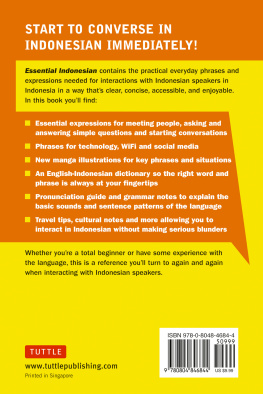
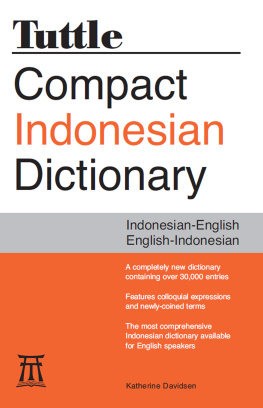
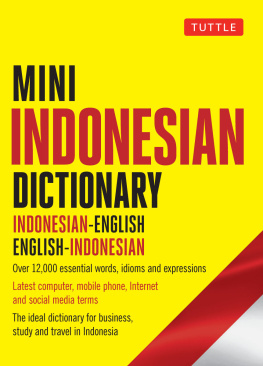
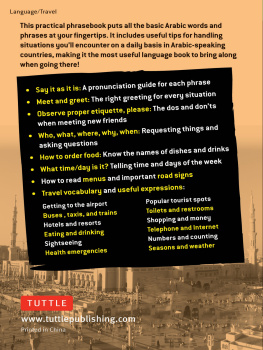



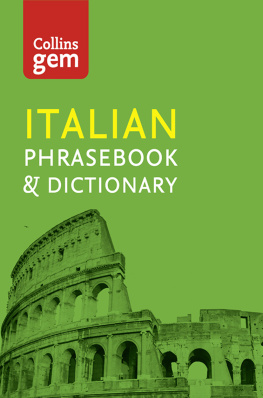





 Tim Hannigan and Katherine Davidsen
Tim Hannigan and Katherine Davidsen Introduction Welcome to the Tuttle Essential Language series, covering all the most popular Asian languages. These books are basic guides to communicating in the language. Theyre concise, accessible and easy to understand, and youll find them indispensable on your trip abroad to get you where you want to go, pay the right prices and do everything youve been planning to do. This book is divided into 14 themed sections. It starts with a pronunciation guide which explains the pronunciation of all the words and sentences youll be learning, and a grammar guide to help you construct basic sentences in Indonesian. The back of this book has a handy EnglishIndonesian dictionary that you can use to look up basic words.
Introduction Welcome to the Tuttle Essential Language series, covering all the most popular Asian languages. These books are basic guides to communicating in the language. Theyre concise, accessible and easy to understand, and youll find them indispensable on your trip abroad to get you where you want to go, pay the right prices and do everything youve been planning to do. This book is divided into 14 themed sections. It starts with a pronunciation guide which explains the pronunciation of all the words and sentences youll be learning, and a grammar guide to help you construct basic sentences in Indonesian. The back of this book has a handy EnglishIndonesian dictionary that you can use to look up basic words. sign beside them. These are designed for situations where you dont understand what someone is saying to you. You can show the book to them and ask them to point to the correct answer to the question you are asking. Other boxes in the bookwithout the symbolprovide listings of themed words with their English translations beside them. For extra clarity, all Indonesian words and phrases are in italics. This book covers every situation you are likely to encounter during your visit, from checking into a hotel to booking a bus or train ticket to shopping and ordering food and drinks at a restaurant.
sign beside them. These are designed for situations where you dont understand what someone is saying to you. You can show the book to them and ask them to point to the correct answer to the question you are asking. Other boxes in the bookwithout the symbolprovide listings of themed words with their English translations beside them. For extra clarity, all Indonesian words and phrases are in italics. This book covers every situation you are likely to encounter during your visit, from checking into a hotel to booking a bus or train ticket to shopping and ordering food and drinks at a restaurant.